gearbox Citroen C4 2014.5 2.G User Guide
[x] Cancel search | Manufacturer: CITROEN, Model Year: 2014.5, Model line: C4, Model: Citroen C4 2014.5 2.GPages: 494, PDF Size: 21.47 MB
Page 161 of 494
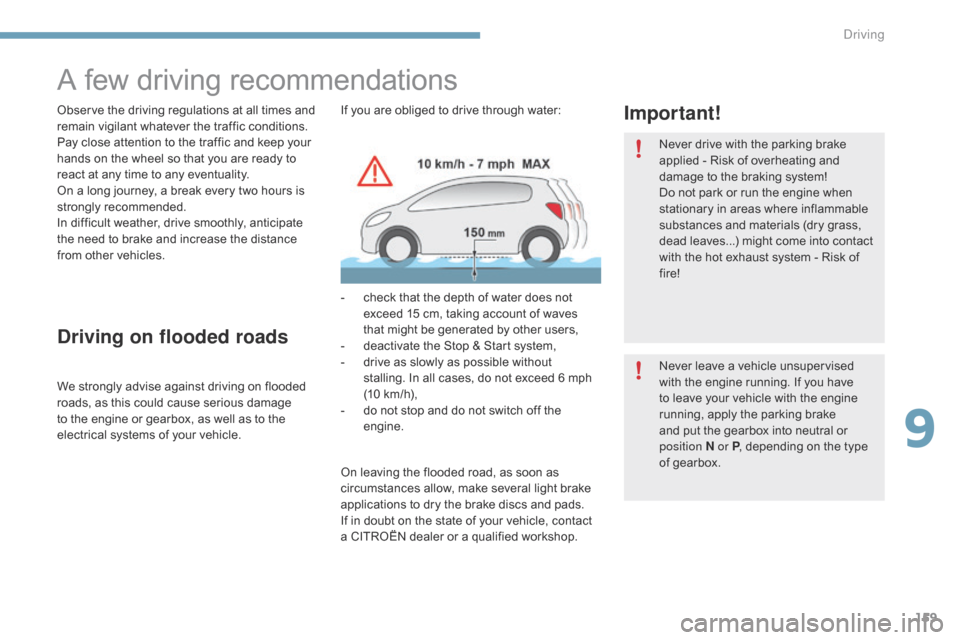
159
A few driving recommendations
Observe the driving regulations at all times and remain vigilant whatever the traffic conditions.
Pay
close attention to the traffic and keep your
h
ands on the wheel so that you are ready to
r
eact at any time to any eventuality.
On
a long journey, a break every two hours is
s
trongly
re
commended.
In
difficult weather, drive smoothly, anticipate
t
he need to brake and increase the distance
f
rom other vehicles.
Driving on flooded roads
We strongly advise against driving on flooded roads, as this could cause serious damage
t
o the engine or gearbox, as well as to the
e
lectrical systems of your vehicle.
Important!If you are obliged to drive through water:
-
c
heck that the depth of water does not
e
xceed 15 cm, taking account of waves
t
hat might be generated by other users,
-
d
eactivate the Stop & Start system,
-
d
rive as slowly as possible without
s
talling. In all cases, do not exceed 6 mph
(
10 km/h),
-
d
o not stop and do not switch off the
e
ngine. Never
drive with the parking brake
a
pplied - Risk of overheating and
d
amage to the braking system!
Do
not park or run the engine when
s
tationary in areas where inflammable
s
ubstances and materials (dry grass,
d
ead leaves...) might come into contact
w
ith the hot exhaust system - Risk of
f
ire!
Never
leave a vehicle unsupervised
w
ith the engine running. If you have
t
o leave your vehicle with the engine
r
unning, apply the parking brake
a
nd put the gearbox into neutral or
p
osition
N or P,
depending on the type
o
f gearbox.
On
leaving the flooded road, as soon as
c
ircumstances allow, make several light brake
a
pplications to dry the brake discs and pads.
If
in doubt on the state of your vehicle, contact
a
CITROËN dealer or a qualified workshop.
9
Driving
Page 163 of 494
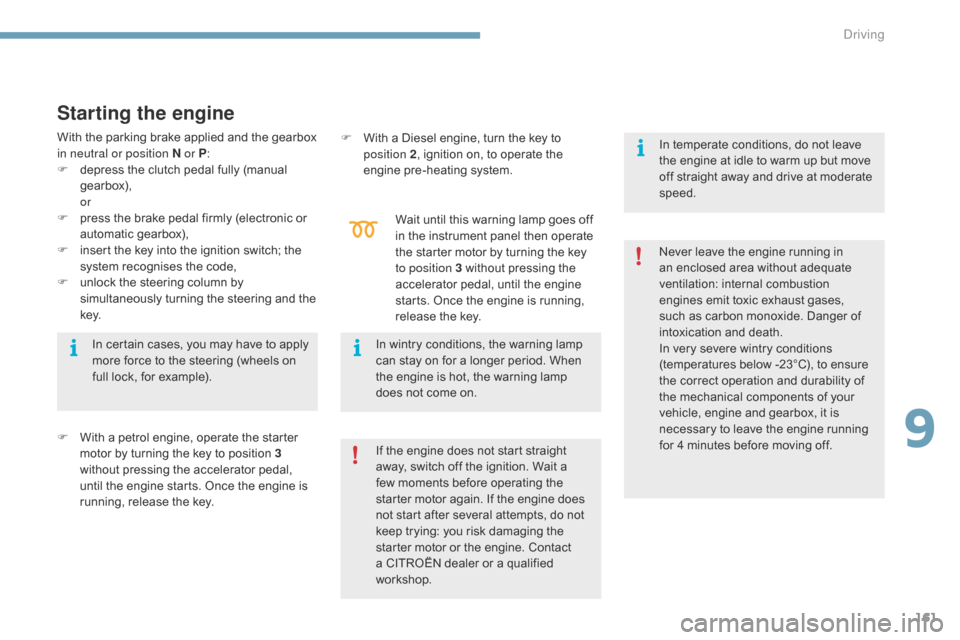
161
Starting the engine
F With a petrol engine, operate the starter m
otor by turning the key to position 3
without
pressing the accelerator pedal,
u
ntil the engine starts. Once the engine is
r
unning, release the key. F
W
ith a Diesel engine, turn the key to
p
osition 2
, ignition on, to operate the
eng
ine
p
re-heating
s
ystem.
Wait until this warning lamp goes off
i
n the instrument panel then operate
t
he starter motor by turning the key
t
o position 3 without pressing the
a
ccelerator pedal, until the engine
s
tarts. Once the engine is running,
r
elease the key.
If the engine does not start straight
a
way, switch off the ignition. Wait a
f
ew moments before operating the
s
tarter motor again. If the engine does
n
ot start after several attempts, do not
k
eep trying: you risk damaging the
s
tarter motor or the engine. Contact
a
CITROËN dealer or a qualified
w
orkshop.Never
leave the engine running in
a
n enclosed area without adequate
v
entilation:
in
ternal
c
ombustion
e
ngines emit toxic exhaust gases,
s
uch as carbon monoxide. Danger of
i
ntoxication and death.
In very severe wintry conditions
(
temperatures below -23°C), to ensure
t
he correct operation and durability of
t
he mechanical components of your
v
ehicle, engine and gearbox, it is n
ecessary to leave the engine running f
or 4 minutes before moving off.
In
certain cases, you may have to apply
m
ore force to the steering (wheels on
f
ull lock, for example).
In wintry conditions, the warning lamp
c
an stay on for a longer period. When
t
he engine is hot, the warning lamp
d
oes not come on.In temperate conditions, do not leave
t
he engine at idle to warm up but move
o
ff straight away and drive at moderate
s
peed.
With the parking brake applied and the gearbox
i
n neutral or position N or P
:
F
d
epress the clutch pedal fully (manual
g
earbox),
or
F
p
ress the brake pedal firmly (electronic or
a
utomatic gearbox),
F
i
nsert the key into the ignition switch; the
s
ystem recognises the code,
F
u
nlock the steering column by
s
imultaneously turning the steering and the
k
ey.
9
Driving
Page 165 of 494
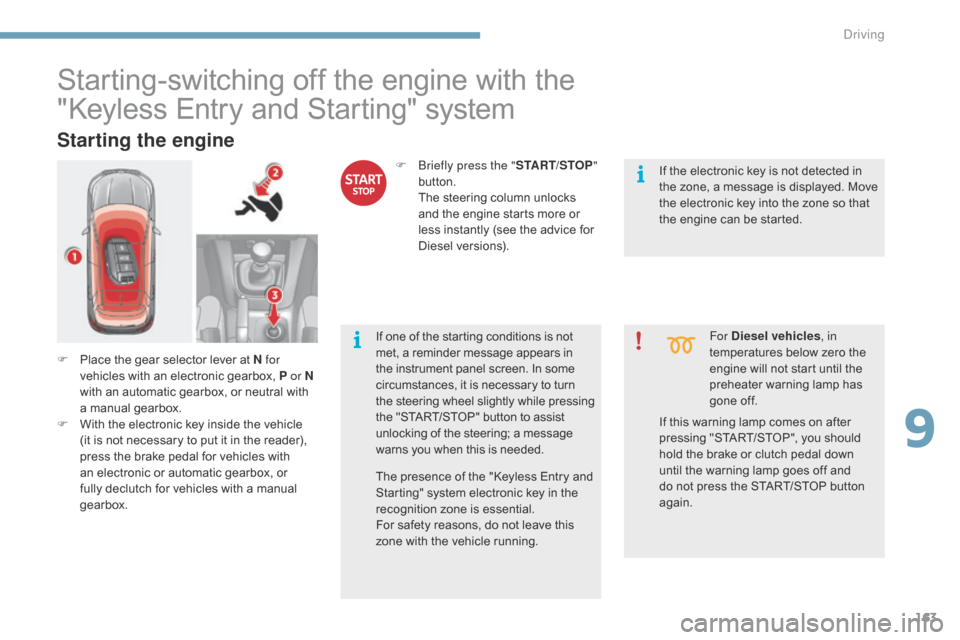
163
Starting-switching off the engine with the
" Keyless Entry and Starting" system
Starting the engine
F Place the gear selector lever at N for
vehicles with an electronic gearbox, P or N
with
an automatic gearbox, or neutral with
a m
anual
g
earbox.
F
W
ith the electronic key inside the vehicle
(
it is not necessary to put it in the reader),
p
ress the brake pedal for vehicles with
a
n electronic or automatic gearbox, or
f
ully declutch for vehicles with a manual
g
earbox. F
b
r
iefly press the "
START/STOP"
button.
T
he steering column unlocks
a
nd the engine starts more or
l
ess instantly (see the advice for
D
iesel
v
ersions).
If this warning lamp comes on after
p
ressing "START/STOP", you should
h
old the brake or clutch pedal down
u
ntil the warning lamp goes off and
d
o not press the START/STOP button
ag
ain.
If
one of the starting conditions is not
m
et, a reminder message appears in t
he instrument panel screen. In some c
ircumstances, it is necessary to turn
t
he steering wheel slightly while pressing
t
he "START/STOP" button to assist
u
nlocking of the steering; a message
w
arns you when this is needed.If
the electronic key is not detected in
t
he zone, a message is displayed. Move
t
he electronic key into the zone so that
t
he engine can be started.
The presence of the "Keyless Entry and
S
tarting" system electronic key in the
r
ecognition zone is essential.
For
safety reasons, do not leave this
z
one with the vehicle running.For Diesel vehicles
, in
temperatures below zero the e
ngine will not start until the
p
reheater warning lamp has
g
one off.
9
driving
Page 166 of 494
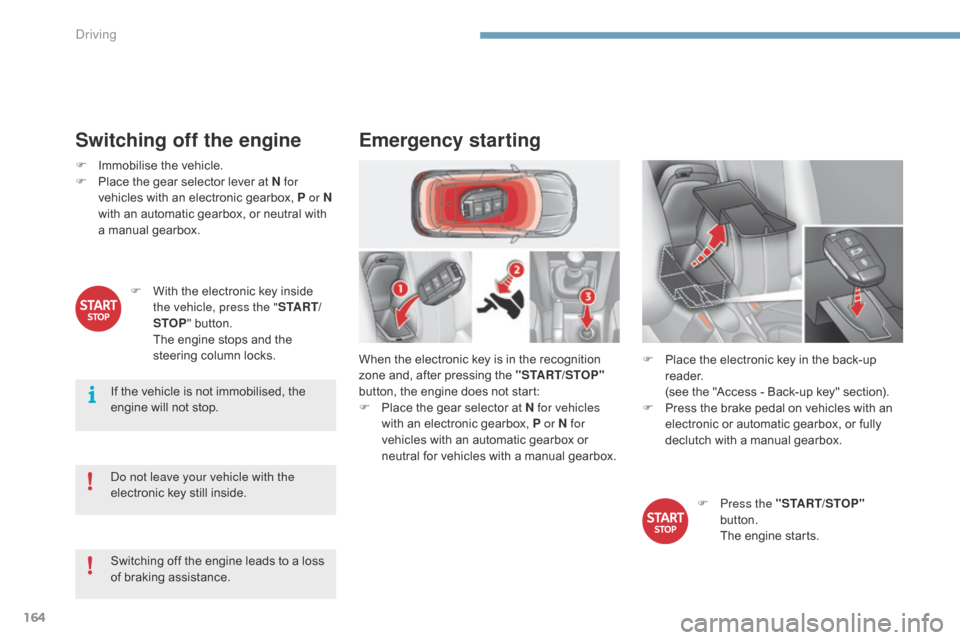
164
Switching off the engine
F Immobilise the vehicle.
F P lace the gear selector lever at N for
vehicles
with an electronic gearbox, P or N
with
an automatic gearbox, or neutral with
a m
anual
g
earbox.
do n
ot leave your vehicle with the
electronic
key still inside.
Switching
off the engine leads to a loss
o
f braking assistance.
If
the vehicle is not immobilised, the
e
ngine will not stop.
F
W
ith the electronic key inside
t
he vehicle, press the " S TA R T/
STOP "
button.
T
he engine stops and the
s
teering column locks.
Emergency starting
When the electronic key is in the recognition zone and, after pressing the "START/STOP"
button,
the engine does not start:
F
P
lace the gear selector at N for vehicles
with
an electronic gearbox, P or N for
vehicles
with an automatic gearbox or
n
eutral for vehicles with a manual gearbox.F
P lace the electronic key in the back-up
re
ader.
(
see the "Access - Back-up key" section).
F
P
ress the brake pedal on vehicles with an
e
lectronic or automatic gearbox, or fully
d
eclutch with a manual gearbox.
F
P
ress the "START/STOP"
button.
T
he engine starts.
Driving
Page 170 of 494
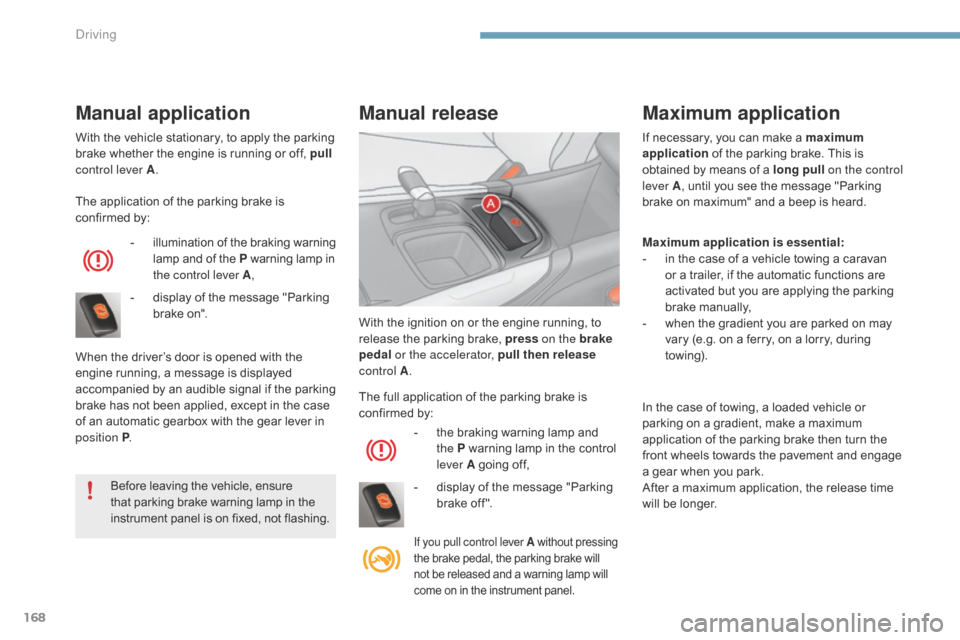
168
With the vehicle stationary, to apply the parking brake whether the engine is running or off, pull
control lever A .
The
application of the parking brake is
c
onfirmed by:
-
i
llumination
o
f
t
he
b
raking
w
arning
l
amp and of the P
warning lamp in
t
he control lever A ,
-
d
isplay of the message "Parking
b
rake on".
When
the driver’s door is opened with the
e
ngine running, a message is displayed
a
ccompanied by an audible signal if the parking
b
rake has not been applied, except in the case
o
f an automatic gearbox with the gear lever in
p
osition P .
Before
leaving the vehicle, ensure
t
hat parking brake warning lamp in the
i
nstrument panel is on fixed, not flashing.
Manual applicationManual release
The full application of the parking brake is c
onfirmed by:
-
t
he braking warning lamp and
t
he P warning lamp in the control
l
ever A going off,
-
d
isplay of the message "Parking
b
rake off ".
If you pull control lever A without pressing t
he brake pedal, the parking brake will n
ot be released and a warning lamp will
c
ome on in the instrument panel.
With the ignition on or the engine running, to release the parking brake, press on the brake
pedal or the accelerator, pull then release
control A . If
necessary, you can make a maximum
application
of the parking brake. This is
o
btained
by m
eans
o
f
a long
pull
on the control
lever A , until you see the message "Parking
b
rake on maximum" and a beep is heard.
In the case of towing, a loaded vehicle or
p
arking on a gradient, make a maximum
a
pplication of the parking brake then turn the
f
ront wheels towards the pavement and engage
a
gear when you park.
After
a maximum application, the release time
w
ill be longer.
Maximum application
Maximum application is essential:
- i n the case of a vehicle towing a caravan
o
r a trailer, if the automatic functions are
a
ctivated but you are applying the parking
b
rake
m
anually,
-
w
hen the gradient you are parked on may
v
ary (e.g. on a ferry, on a lorry, during
tow
ing).
Driving
Page 171 of 494
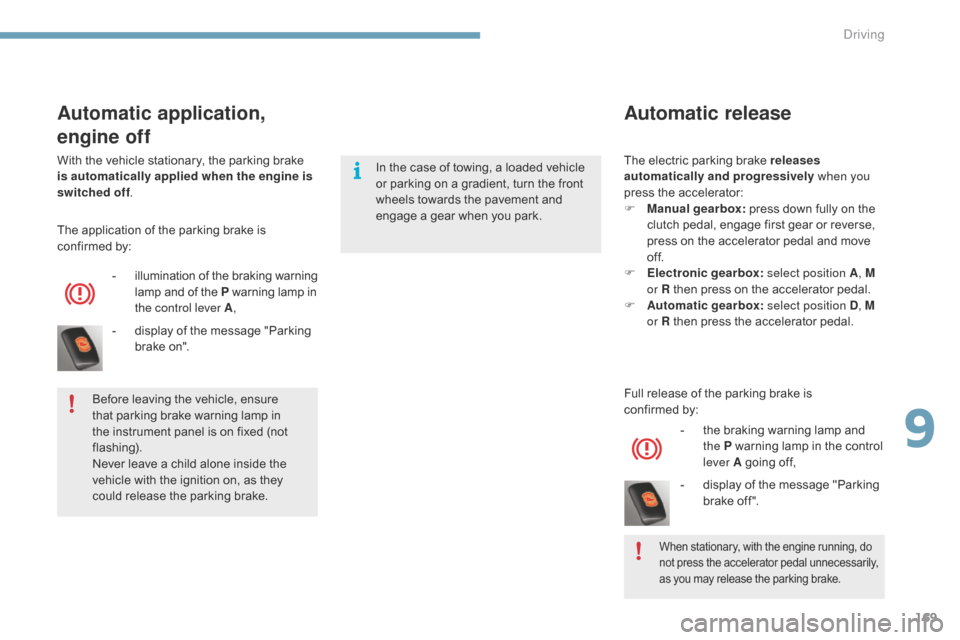
169
Automatic release
Full release of the parking brake is
c onfirmed by:
-
t
he braking warning lamp and
t
he P warning lamp in the control
l
ever A going off,
-
d
isplay of the message "Parking
b
rake off ".
Automatic application,
engine off
- illumination of t he b raking w arning l
amp and of the P warning lamp in t
he control lever A ,
-
d
isplay of the message "Parking
b
rake on".
The
application of the parking brake is
c
onfirmed by:
With
the
vehicle stationary, the parking brake
i
s automatically applied when the engine is
switched off .
Before leaving the vehicle, ensure
t
hat parking brake warning lamp in
t
he
instrument panel is on fixed (not
f
lashing).
Never
leave a child alone inside the
v
ehicle with the ignition on, as they
c
ould release the parking brake.
When stationary, with the engine running, do not press the accelerator pedal unnecessarily, a
s you may release the parking brake.
In the case of towing, a loaded vehicle or parking on a gradient, turn the front
w
heels towards the pavement and
e
ngage a gear when you park.The
electric parking brake releases
automatically and progressively when you
press
the accelerator:
F
M
anual gearbox:
press down fully on the
c
lutch pedal, engage first gear or reverse,
p
ress on the accelerator pedal and move
o
f f.
F
E
lectronic gearbox: select position A, M
or R
then press on the accelerator pedal.
F
A
utomatic gearbox: select position D, M
or R
then press the accelerator pedal.
9
Driving
Page 172 of 494
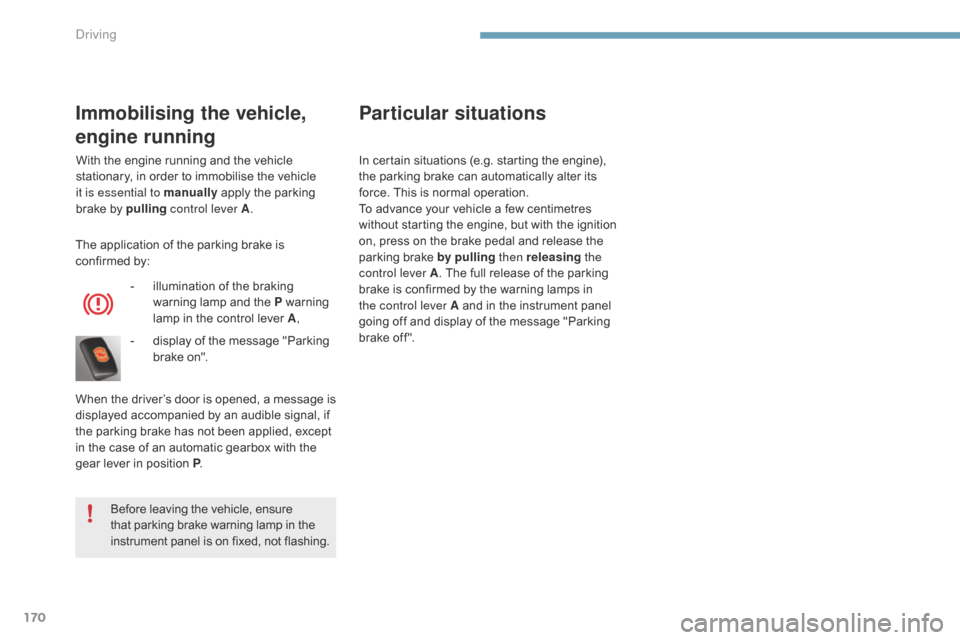
170
Immobilising the vehicle,
engine running
- illumination of the braking w
arning lamp and the P warning
l
amp in the control lever A,
-
d
isplay of the message "Parking
b
rake on".
Particular situations
In certain situations (e.g. starting the engine), the parking brake can automatically alter its
f
orce. This is normal operation.
To
advance your vehicle a few centimetres
w
ithout starting the engine, but with the ignition
o
n, press on the brake pedal and release the
p
arking brake by pulling then releasing the
control lever A .
The full release of the parking
b
rake is confirmed by the warning lamps in
t
he control lever A and in the instrument panel
g
oing off and display of the message "Parking
b
rake off ".
When
the
driver’s
door
is
opened,
a
message
is
d
isplayed
accompanied
by
an
audible
signal,
if
t
he
parking
brake
has
not
been
applied,
except
i
n
the
case
of
an
automatic
gearbox
with
the
g
ear
lever
in
position
P .
The
application
of
the
parking
brake
is
c
onfirmed
by:
With
the
engine
running
and
the
vehicle
s
tationary,
in
order
to
immobilise
the
vehicle
i
t is essential to manually
apply
the
parking
b
rake
by
pulling control lever A .
Before
leaving
the
vehicle,
ensure
t
hat
parking
brake
warning
lamp
in
the
i
nstrument
panel
is
on
fixed,
not
flashing.
Driving
Page 177 of 494
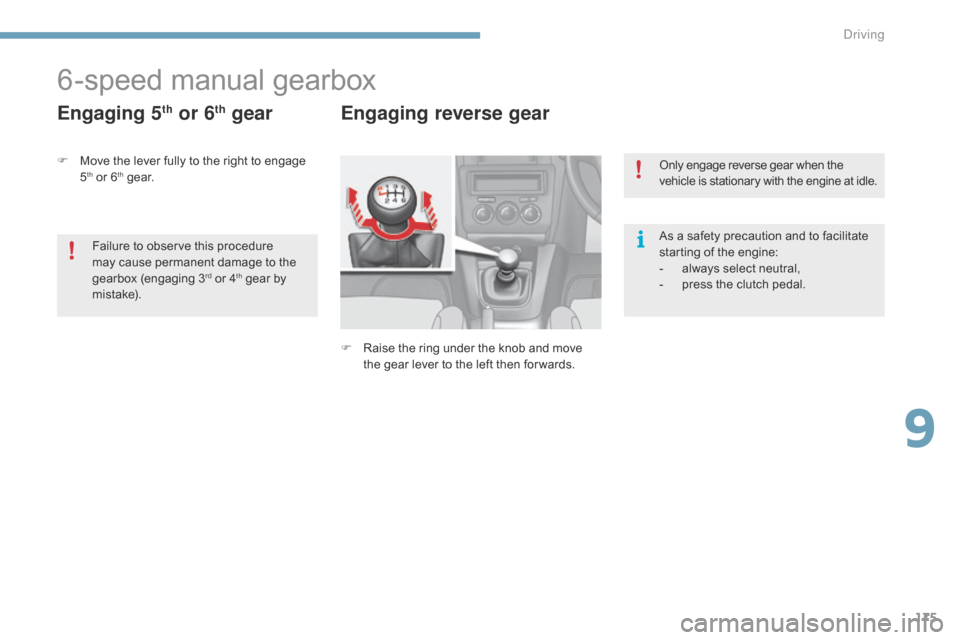
175
6-speed manual gearbox
Engaging 5th or 6th gear Engaging reverse gear
F Raise the ring under the knob and move t
he gear lever to the left then for wards.Only
engage reverse gear when the
v
ehicle is stationary with the engine at idle.
As a safety precaution and to facilitate
s
tarting of the engine:
-
a
lways select neutral,
-
p
ress the clutch pedal.
F
M
ove
the
lever
fully
to
the
right
to
engage
5th or 6th ge a r.
Failure to observe this procedure
m
ay
cause permanent damage to the
g
earbox
(
engaging
3rd or 4th gear by m
i st a ke).
9
Driving
Page 178 of 494
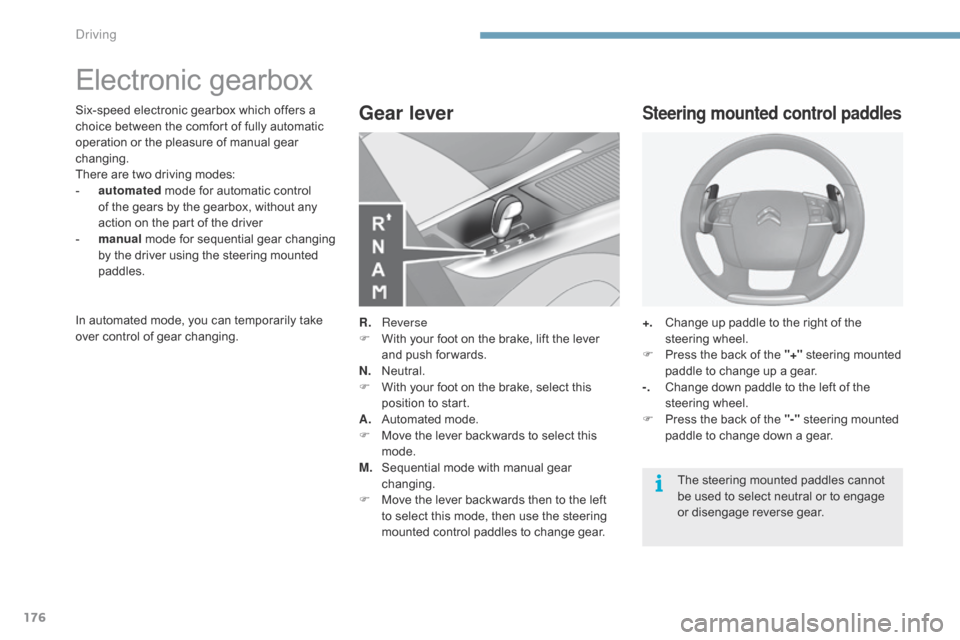
176
Electronic gearbox
Six-speed electronic gearbox which offers a c
hoice between the comfort of fully automatic
o
peration or the pleasure of manual gear
c
hanging.
There
are two driving modes:
-
a
utomated
mode for automatic control
o
f the gears by the gearbox, without any
a
ction on the part of the driver
-
m
anual
mode for sequential gear changing
b
y the driver using the steering mounted
p
addles. R.
R
everse
F
W
ith your foot on the brake, lift the lever
an
d
p
ush
fo
rwards.
N.
N
eutral.
F
W
ith your foot on the brake, select this
p
osition to start.
A.
A
utomated mode.
F
M
ove the lever backwards to select this
m
ode.
M.
S
equential mode with manual gear
c
hanging.
F
M
ove the lever backwards then to the left
t
o select this mode, then use the steering
m
ounted control paddles to change gear.Gear lever
+. Change up paddle to the right of the s
teering w heel.
F
P
ress the back of the "+"
steering mounted
p
addle to change up a gear.
-.
C
hange down paddle to the left of the
s
teering
w
heel.
F
P
ress the back of the "-"
steering mounted
p
addle to change down a gear.
Steering mounted control paddles
In automated mode, you can temporarily take over control of gear changing.
The
steering mounted paddles cannot
b
e used to select neutral or to engage
o
r
d
isengage
r
everse
g
ear.
Driving
Page 180 of 494
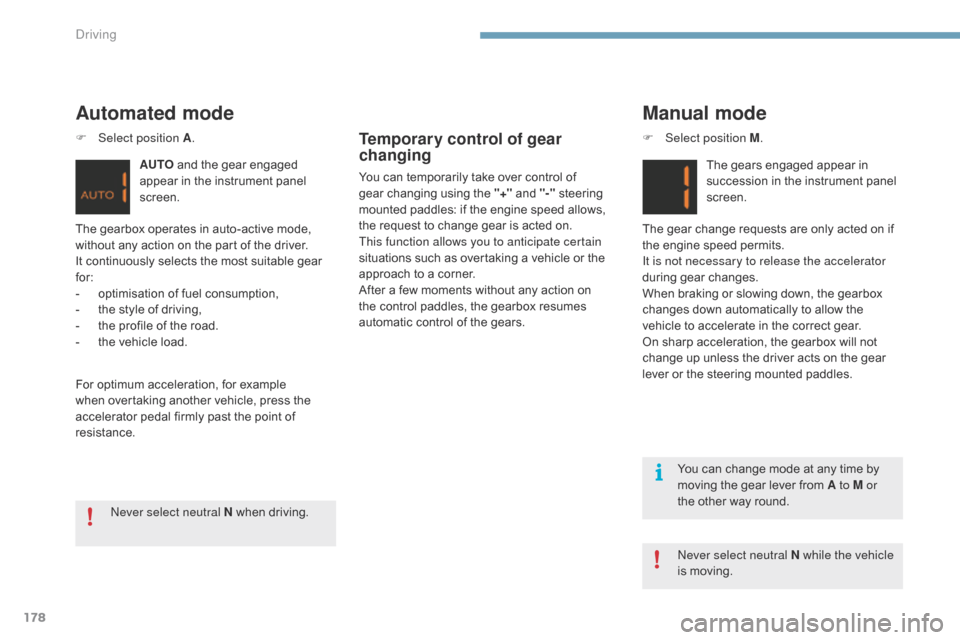
178
Automated mode
For optimum acceleration, for example when overtaking another vehicle, press the
a
ccelerator pedal firmly past the point of
r
esistance.
The
gearbox operates in auto-active mode,
w
ithout any action on the part of the driver.
It continuously selects the most suitable gear
fo
r:
-
o
ptimisation of fuel consumption,
-
t
he style of driving,
-
t
he profile of the road.
-
t
he vehicle load.
AUTO
and the gear engaged
a
ppear in the instrument panel
sc
reen.
ne
ver select neutral N while the vehicle
is
moving.
ne
ver select neutral N
w
hen
d
riving. You
can change mode at any time by
m
oving the gear lever from A to M or
the
other way round.
F
Sel
ect position A
.
Temporary control of gear
changing
You can temporarily take over control of g
ear changing using the "+" and "-" steering
m
ounted paddles: if the engine speed allows,
t
he request to change gear is acted on.
This function allows you to anticipate certain
situations
such as overtaking a vehicle or the
a
pproach to a corner.
After
a few moments without any action on
t
he control paddles, the gearbox resumes
a
utomatic control of the gears.
Manual mode
The gears engaged appear in succession in the instrument panel
sc
reen.
The
gear
change requests are only acted on if
t
he
engine
speed permits.
It is not necessary to release the accelerator
during
gear
changes.
When
braking or slowing down, the gearbox
c
hanges
down automatically to allow the
v
ehicle
to
accelerate in the correct gear.
On
sharp
acceleration, the gearbox will not
c
hange
up
unless the driver acts on the gear
l
ever
or
the
steering mounted paddles.
F
Sel
ect position M
.
Driving